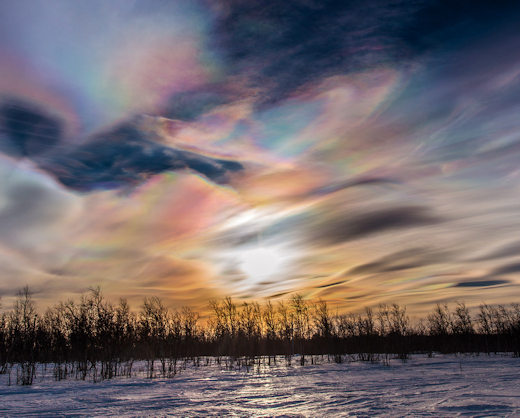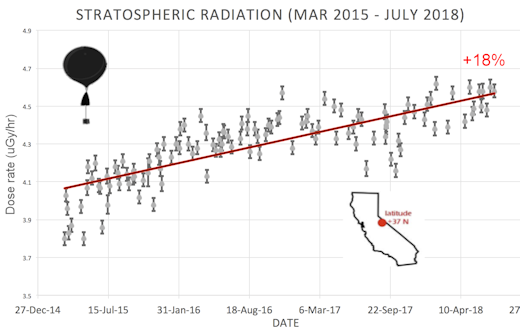Lights Over Lapland has a brand-new website full of exciting adventures in Abisko National Park, Sweden! Take a look at our aurora activities and book your once-in-a-lifetime trip with us today! | | |
TWO DAYS FROM ULTIMA THULE: NASA's New Horizons spacecraft is closing in on Ultima Thule, a mysterious object 4 billion miles from Earth. On New Year's Eve and New Year's Day, New Horizons will swoop three times closer to Ultima Thule than it flew past Pluto in 2015. "The anticipation is palpable now: we are on the verge of an important scientific exploration almost 20 years in the making and, in many ways, unlike any other ever attempted," says the mission's principal investigator Alan Stern. Stay tuned for live coverage despite the US government shutdown.
RARE VIDEO OF CLOUDS IN THE STRATOSPHERE: The habits of a weatherman are hard to break--even on holiday. So it was that Dutch meteorologist Jacob Kuiper found himself outside on Christmas morning, looking up. What he saw amazed him. "The sky was filling with strange clouds," says Kuiper. "At first I thought they were some form of cirrus, but these clouds were uncommonly wavy with unusual curls. When I saw the telltale flashes of color, I realized they must be polar stratospheric clouds (PSCs)."
Kuiper made a time-lapse video of the display. Note the hypnotic waves and how, at the 25 second mark, ordinary clouds may be seen scudding far below them:
Polar stratospheric clouds are not your ordinary Christmas clouds. Indeed, they have little to do with regular weather, floating so high above Earth that even airplanes cannot reach them.
Normally, the stratosphere is free of clouds--completely transparent. It's very dry up there with a wide separation between molecules of water. When the temperature drops to around -85ºC, however, those sparse molecules begin to reluctantly gather, forming crystals of ice that become PSCs.
"I have been working in the National Meteorological Office in the central part of The Netherlands (KNMI) for 40 years," says Kuiper. "Only twice have I seen a display of stratospheric clouds this widespread. It was thrilling. I didn't expect the stratosphere over our country to be cold enough, but one of the stratosphere scientists in our Met. Office confirmed my idea. He also was quite surprised."

Above: PSCs inside the Arctic Circle in 2017. Photo credit: Mia Stålnacke of Kiruna, Sweden
Tiny ice crystals in PSCs can produce episodes of iridescence so brilliant that they are sometimes mistaken for auroras. The display Kuiper recorded contained only a few brief flashes of those colors--just enough for an identification.
PSCs come in two varieties: Type I contains hydrated droplets of nitric acid and sulphuric acid. These are chemicals that can destroy ozone. Indeed, an ozone hole formed over the UK in Feb. 2016 following an outbreak of Type 1 PSCs. Type II PSCs are icy and colorful, and they do little damage to the ozone layer. The clouds Kuiper witnessed may be a mixture of both.
The display was so rare that researchers in the Met Office conducted an extra round of Christmas radio soundings to probe the stratosphere. They are still processing the data, so stay tuned!
Realtime Space Weather Photo Gallery
BUY A TICKET TO THE EDGE OF SPACE: Extended by popular demand! For the holiday season only, we're reducing the cost of payload space on Earth to Sky Calculus balloons from $500 to only $299. Buy an edge of space gift certificate before New Year's Eve and you can send an experiment, photo, or keepsake item to the stratosphere, completely supported by an Earth to Sky Calculus launch and recovery team.

This is not only a great belated Christmas gift, but also a good kickstarter for science fair projects. Experiments will be flown and returned along with video footage, GPS tracking, temperature, pressure, altimetry and radiation data.
To take advantage of the discounted rate, payment must be received before Dec. 25th. However, the flight can take place at any time in the next 12 months. You'll receive the ticket electronically so you can print it out and give it as a Christmas Day gift.
Far Out Gifts: Earth to Sky Store
All sales support hands-on STEM education
Realtime Comet Photo Gallery
Realtime Aurora Photo Gallery
Every night, a network of
NASA all-sky cameras scans the skies above the United States for meteoritic fireballs. Automated software maintained by NASA's Meteoroid Environment Office calculates their orbits, velocity, penetration depth in Earth's atmosphere and many other characteristics. Daily results are presented here on Spaceweather.com.
On Dec. 28, 2018, the network reported 17 fireballs.
(17 sporadics)

In this diagram of the inner solar system, all of the fireball orbits intersect at a single point--Earth. The orbits are color-coded by velocity, from slow (red) to fast (blue). [Larger image] [movies]
Potentially Hazardous Asteroids (
PHAs) are space rocks larger than approximately 100m that can come closer to Earth than 0.05 AU. None of the known PHAs is on a collision course with our planet, although astronomers are finding
new ones all the time.
On December 29, 2018 there were 1947 potentially hazardous asteroids.
 |
Recent & Upcoming Earth-asteroid encounters: | Asteroid | Date(UT) | Miss Distance | Velocity (km/s) | Diameter (m) |
| 418849 | 2018-Dec-23 | 16.6 LD | 17.6 | 269 |
| 2018 XN5 | 2018-Dec-24 | 3 LD | 6.4 | 30 |
| 2018 XE4 | 2018-Dec-26 | 5.4 LD | 9.4 | 18 |
| 2014 AD16 | 2019-Jan-04 | 12.9 LD | 9.4 | 12 |
| 2018 XO4 | 2019-Jan-06 | 7.8 LD | 4 | 31 |
| 2016 AZ8 | 2019-Jan-07 | 11.6 LD | 9.1 | 224 |
| 2013 YM2 | 2019-Jan-09 | 7.3 LD | 4.3 | 20 |
| 2018 XN | 2019-Jan-14 | 11.9 LD | 5.6 | 59 |
| 2013 CW32 | 2019-Jan-29 | 13.9 LD | 16.4 | 148 |
| 2013 RV9 | 2019-Feb-06 | 17.9 LD | 5.9 | 68 |
| 2017 PV25 | 2019-Feb-12 | 7.3 LD | 6.1 | 43 |
| 455176 | 2019-Feb-20 | 19.2 LD | 26.5 | 269 |
| 2016 CO246 | 2019-Feb-22 | 15.8 LD | 5.5 | 23 |
Notes: LD means "Lunar Distance." 1 LD = 384,401 km, the distance between Earth and the Moon. 1 LD also equals 0.00256 AU. MAG is the visual magnitude of the asteroid on the date of closest approach. | | Cosmic Rays in the Atmosphere |
SOMETHING NEW! We have developed a new predictive model of aviation radiation. It's called E-RAD--short for Empirical RADiation model. We are constantly flying radiation sensors onboard airplanes over the US and and around the world, so far collecting more than 22,000 gps-tagged radiation measurements. Using this unique dataset, we can predict the dosage on any flight over the USA with an error no worse than 15%.
E-RAD lets us do something new: Every day we monitor approximately 1400 flights criss-crossing the 10 busiest routes in the continental USA. Typically, this includes more than 80,000 passengers per day. E-RAD calculates the radiation exposure for every single flight.
The Hot Flights Table is a daily summary of these calculations. It shows the 5 charter flights with the highest dose rates; the 5 commercial flights with the highest dose rates; 5 commercial flights with near-average dose rates; and the 5 commercial flights with the lowest dose rates. Passengers typically experience dose rates that are 20 to 70 times higher than natural radiation at sea level.
To measure radiation on airplanes, we use the same sensors we fly to the stratosphere onboard Earth to Sky Calculus cosmic ray balloons: neutron bubble chambers and X-ray/gamma-ray Geiger tubes sensitive to energies between 10 keV and 20 MeV. These energies span the range of medical X-ray machines and airport security scanners.
Column definitions: (1) The flight number; (2) The maximum dose rate during the flight, expressed in units of natural radiation at sea level; (3) The maximum altitude of the plane in feet above sea level; (4) Departure city; (5) Arrival city; (6) Duration of the flight.
SPACE WEATHER BALLOON DATA: Approximately once a week, Spaceweather.com and the students of Earth to Sky Calculus fly space weather balloons to the stratosphere over California. These balloons are equipped with radiation sensors that detect cosmic rays, a surprisingly "down to Earth" form of space weather. Cosmic rays can seed clouds, trigger lightning, and penetrate commercial airplanes. Furthermore, there are studies ( #1, #2, #3, #4) linking cosmic rays with cardiac arrhythmias and sudden cardiac death in the general population. Our latest measurements show that cosmic rays are intensifying, with an increase of more than 18% since 2015:

The data points in the graph above correspond to the peak of the Reneger-Pfotzer maximum, which lies about 67,000 feet above central California. When cosmic rays crash into Earth's atmosphere, they produce a spray of secondary particles that is most intense at the entrance to the stratosphere. Physicists Eric Reneger and Georg Pfotzer discovered the maximum using balloons in the 1930s and it is what we are measuring today.
En route to the stratosphere, our sensors also pass through aviation altitudes:

In this plot, dose rates are expessed as multiples of sea level. For instance, we see that boarding a plane that flies at 25,000 feet exposes passengers to dose rates ~10x higher than sea level. At 40,000 feet, the multiplier is closer to 50x.
The radiation sensors onboard our helium balloons detect X-rays and gamma-rays in the energy range 10 keV to 20 MeV. These energies span the range of medical X-ray machines and airport security scanners.
Why are cosmic rays intensifying? The main reason is the sun. Solar storm clouds such as coronal mass ejections (CMEs) sweep aside cosmic rays when they pass by Earth. During Solar Maximum, CMEs are abundant and cosmic rays are held at bay. Now, however, the solar cycle is swinging toward Solar Minimum, allowing cosmic rays to return. Another reason could be the weakening of Earth's magnetic field, which helps protect us from deep-space radiation.
| | The official U.S. government space weather bureau |
| | The first place to look for information about sundogs, pillars, rainbows and related phenomena. |
| | Researchers call it a "Hubble for the sun." SDO is the most advanced solar observatory ever. |
| | 3D views of the sun from NASA's Solar and Terrestrial Relations Observatory |
| | Realtime and archival images of the Sun from SOHO. |
| | from the NOAA Space Environment Center |
| | fun to read, but should be taken with a grain of salt! Forecasts looking ahead more than a few days are often wrong. |
| | from the NOAA Space Environment Center |
| | the underlying science of space weather |
 | If you are a Youtuber and want to buy real Youtube views than try out Buyrealsocial.com for the best results possible! |
 | To find reviews of new online casino sites in the UK try The Casino DB where there are hundreds of online casino reviews complete with bonuses and ratings. Looking for a new online casino? Try Casimpo the new site dedicated to making online casino simple and easy for all. |
| | These links help Spaceweather.com stay online. Thank you to our supporters! |
| | | | | | |

